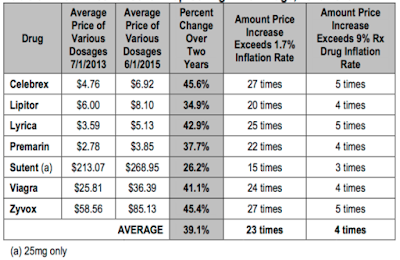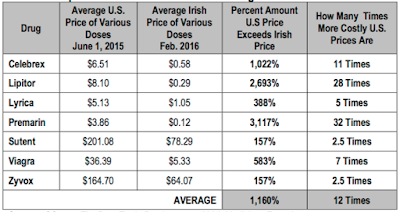This article was last updated on April 16, 2022
Canada: ![]() Oye! Times readers Get FREE $30 to spend on Amazon, Walmart…
Oye! Times readers Get FREE $30 to spend on Amazon, Walmart…
USA: ![]() Oye! Times readers Get FREE $30 to spend on Amazon, Walmart…
Oye! Times readers Get FREE $30 to spend on Amazon, Walmart…
Now that the $160 billion Pfizer – Allergen merger has died, I wanted to take this opportunity to look at some of the details in the Americans for Tax Fairness report entitled "Pfizer: Price Gouger, Tax Dodger". Rather than focus on the tax aspect of the deal (if you recall, it was an inversion deals that would have seen Pfizer legally dodge up to $35 billion in taxes through its newfound "Irishness"), I want to focus on how Pfizer treats its most important stakeholders; its customer base.
Let's start with this table that shows the price hikes for seven of Pfizer's top-selling drugs between 2013 and 2015 and how much the price hikes exceed the inflation rate:
Notice that the average two-year price hike for these seven drugs was 39.1 percent between 2013 and 2015. Some of these drugs are very frequently used by consumers; Celebrex, is an anti inflammatory drug which is used for arthritic pain relief, Lipitor is used to reduce the level of low-density lipoproteins and triglycerides in the blood and Viagra is used to treat the much-dreaded erectile dysfunction. Speaking of getting stiffed, why not hit men looking for an erection with a 41 percent price increase over two years and a 72 percent increase over three years? Most men with erectile dysfunction would be happy to pay just about anything to put a bit of stiffness into things.
Since a big portion of America's drug purchases are made through Medicare (i.e. the American taxpayer), let's look at how much of a price increase Pfizer passed along for one drug to taxpayers. Lyrica ,which was first released in 2004, is an anticonvulsant which can be used to control epileptic seizures by slowing down impulses in the brain. It can also affect the chemicals in the brain that send out pain signals; as such, it can be used to treat pain caused by nerve damage in people with diabetes and herpes zoster (shingles). It can also treat pain in people suffering from fibromyalgia. Under Medicare's Part D prescription drug program, Lyrica purchases totalled more than $1.4 billion in 2014. Looking back in time, Pfizer was paid $2.42 per unit in 2010 for Lyrica; this rose to $4.28 in 2014, an increase of 77 percent. As if that injury wasn't enough, Pfizer added additional insult by increasing the price of Lyrica twice in 2015 by 9.4 percent each time. Lyrica, Pfizer's best selling drug in 2014, was expected to be its second biggest global seller in 2015 with $4.848 billion in sales. Pfizer's exclusive rights to Lyrica expire on December 30, 2018, well after the company has made billions of dollars in profits on a single product.
Since Pfizer was looking to become more Irish, let's look at a table showing a comparison of how much consumers in Ireland pay for the same drugs:
On average, American consumers pay 12 times as much for these seven drugs as their Irish counterparts.
Now that we've looked at Pfizer's drug pricing strategy, let's look at its revenues, net income and overall profit margin for the tax years between 2011 and 2015 to help us gain a sense of how those drug price increases have helped the company's bottom line:
Note that Pfizer's profit margin is up nearly 50 percent from 2011 to 2015. Interestingly, Pfizer reported losing $16.3 billion in the United States between 2010 and 2014 but earned $78.1 billion offshore even though the company had 38 percent of its sales and 48 percent of its assets in the United States. This is due to Pfizer's ability to move profits from the United States to one of its 151 subsidiaries in ten overseas tax havens.
While all of this may appear unfair, Pfizer benefits directly from American taxpayers in other ways. Over the past five years, Pfizer has received $590.7 million in tax breaks as shown on this table:
Under federal tax law, the Research and Experimentation Creditprovides Pfizer with a research tax credit that equals 20 percent of qualified research expenditures above 50 percent of a company's average annual qualified research expenditures in the three most recent tax years. The purpose of the credit is to stimulate more business through research and development investment than would otherwise occur by lowering the after-tax cost of the research. While this may be the case for many industries, in the case of Big Pharma, even with the research tax credits, much of their efforts go to delaying the introduction of much cheaper generic alternatives, changes that would mean substantial losses in revenue for drug companies and substantial savings for consumers.
As we can see from the data in this posting, even without the Pfizer-Allergan merger which would have saved the company tens of billions of dollars in taxes, Pfizer has a history of gouging its customers by boosting the price of its top-selling drugs far beyond both the headline inflation rate and the prescription drug inflation rate and, in addition, selling those drugs at prices that are far higher than other jurisdictions. The high cost of drugs is a contributing factor to America's poorer health outcomes since even middle income families are often unable to afford drugs that may improve their health outcomes and allow them to avoid medically-related bankruptcies at the same time. On top of that, not only is Pfizer benefitting from selling its drugs to America's taxpayers through its sales to the Medicare Part D drug program, it is lining up at the public trough to avail itself of tax breaks for its research and development programs.
Click HERE to read more of Glen Asher's columns
You can publish this article on your website as long as you provide a link back to this page.





Be the first to comment